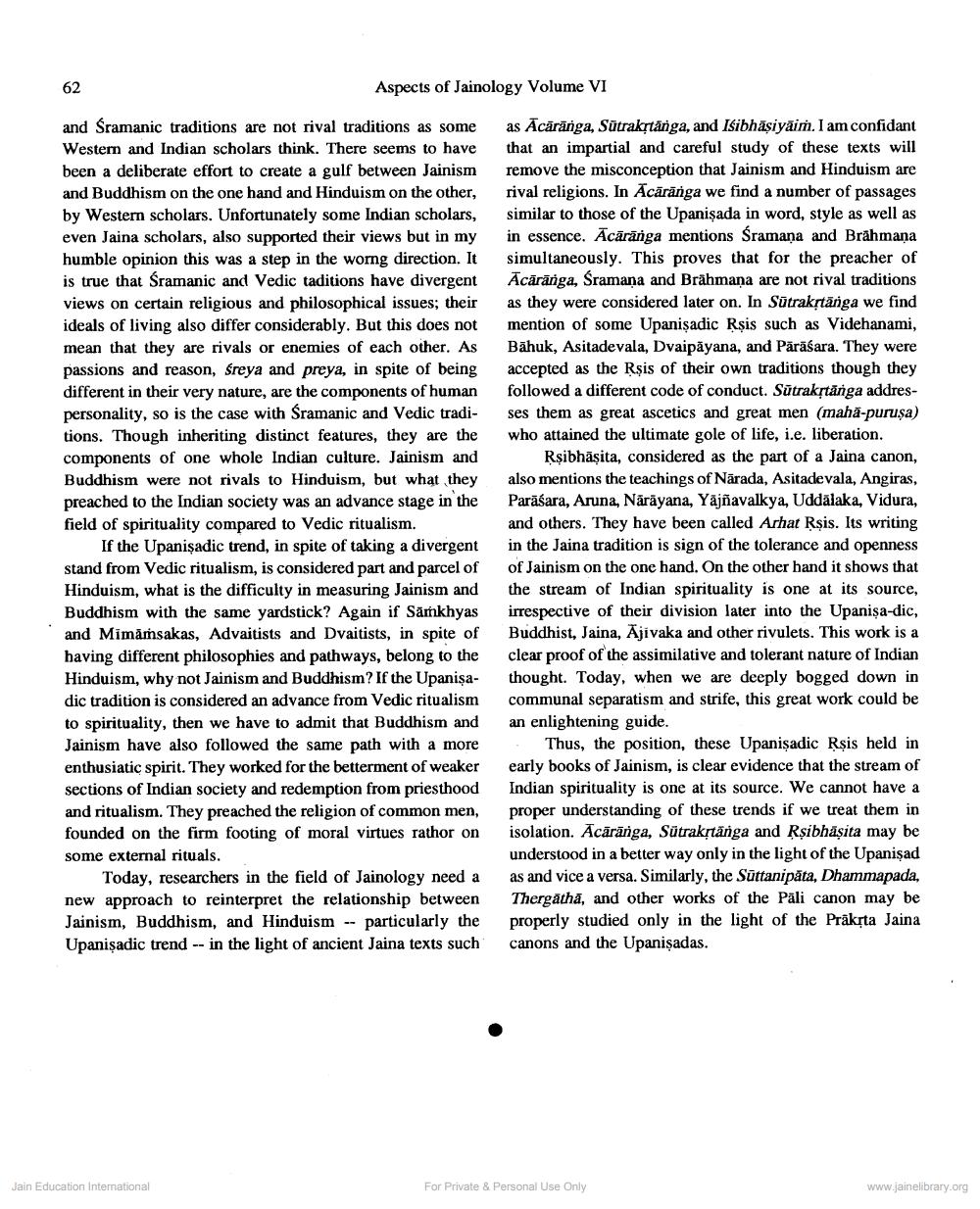________________ 62 Aspects of Jainology Volume VI and Sramanic traditions are not rival traditions as some Western and Indian scholars think. There seems to have been a deliberate effort to create a gulf between Jainism and Buddhism on the one hand and Hinduism on the other, by Western scholars. Unfortunately some Indian scholars, even Jaina scholars, also supported their views but in my humble opinion this was a step in the worng direction. It is true that Sramanic and Vedic taditions have divergent views on certain religious and philosophical issues; their ideals of living also differ considerably. But this does not mean that they are rivals or enemies of each other. As passions and reason, sreya and preya, in spite of being different in their very nature, are the components of human personality, so is the case with sramanic and Vedic traditions. Though inheriting distinct features, they are the components of one whole Indian culture. Jainism and Buddhism were not rivals to Hinduism, but what they preached to the Indian society was an advance stage in the field of spirituality compared to Vedic ritualism. If the Upanisadic trend, in spite of taking a divergent stand from Vedic ritualism, is considered part and parcel of Hinduism, what is the difficulty in measuring Jainism and Buddhism with the same yardstick? Again if Samkhyas and Mimamsakas, Advaitists and Dvaitists, in spite of having different philosophies and pathways, belong to the Hinduism, why not Jainism and Buddhism? If the Upanisa- dic tradition is considered an advance from Vedic ritualism to spirituality, then we have to admit that Buddhism and Jainism have also followed the same path with a more enthusiatic spirit. They worked for the betterment of weaker sections of Indian society and redemption from priesthood and ritualism. They preached the religion of common men, founded on the firm footing of moral virtues rathor on some external rituals. Today, researchers in the field of Jainology need a new approach to reinterpret the relationship between Jainism, Buddhism, and Hinduism -- particularly the Upanisadic trend -- in the light of ancient Jaina texts such as Acararga, Sutrakntarga, and Isibhasiyaim. I am confidant that an impartial and careful study of these texts will remove the misconception that Jainism and Hinduism are rival religions. In Acaranga we find a number of passages similar to those of the Upanisada in word, style as well as in essence. Acarariga mentions sramana and Brahmana simultaneously. This proves that for the preacher of Acararga, Sramana and Brahmana are not rival traditions as they were considered later on. In Sutrakrtanga we find mention of some Upanisadic Rsis such as Videhanami, Bahuk, Asitadevala, Dvaipayana, and Parasara. They were accepted as the Rsis of their own traditions though they followed a different code of conduct. Sutrakstanga addresses them as great ascetics and great men (maha-purusa) who attained the ultimate gole of life, i.e. liberation. Rsibhasita, considered as the part of a Jaina canon, also mentions the teachings of Narada, Asitadevala, Angiras, Parasara, Aruna, Narayana, Yajnavalkya, Uddaiaka, Vidura, and others. They have been called Arhat Rsis. Its writing in the Jaina tradition is sign of the tolerance and openness of Jainism on the one hand. On the other hand it shows that the stream of Indian spirituality is one at its source, irrespective of their division later into the Upanisa-dic, Buddhist, Jaina, Ajivaka and other rivulets. This work is a clear proof of the assimilative and tolerant nature of Indian thought. Today, when we are deeply bogged down in communal separatism and strife, this great work could be an enlightening guide. . Thus, the position, these Upanisadic Rsis held in early books of Jainism, is clear evidence that the stream of Indian spirituality is one at its source. We cannot have a proper understanding of these trends if we treat them in isolation. Acaranga, Sutrakrtanga and Rsibhasita may be understood in a better way only in the light of the Upanisad as and vice a versa. Similarly, the Suttanipata, Dhammapada, Thergatha, and other works of the Pali canon may be properly studied only in the light of the Prakrta Jaina canons and the Upanisadas. Jain Education International For Private & Personal Use Only www.jainelibrary.org




